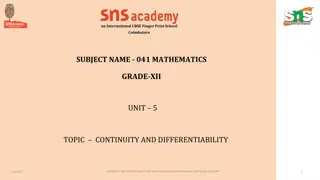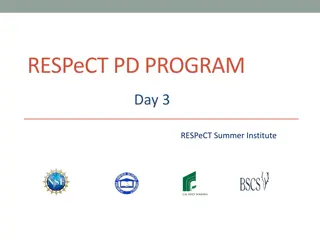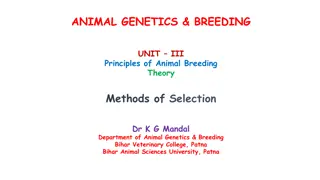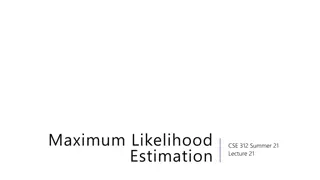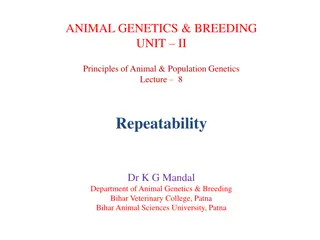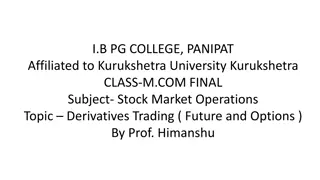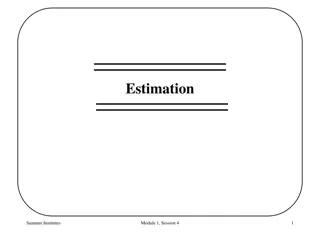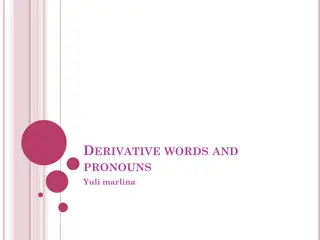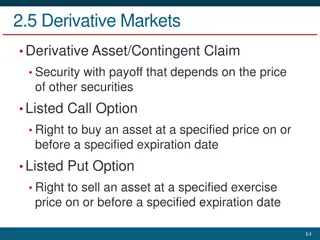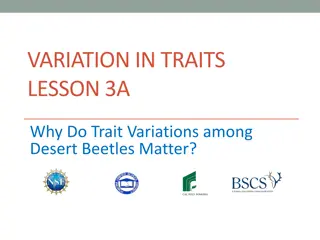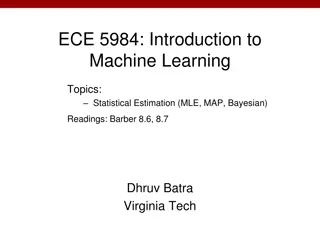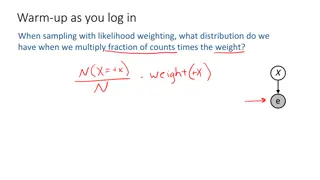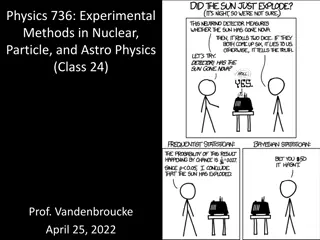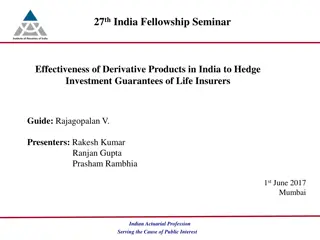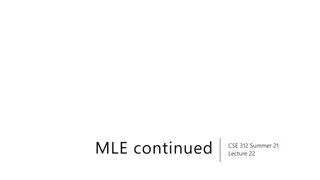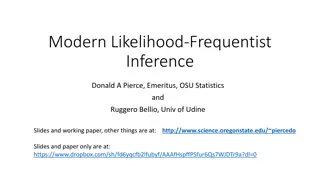MTDFREML - Multiple Trait Derivative-Free Maximum Likelihood Analysis
This content covers MTDFREML - Multiple Trait Derivative-Free Restricted Maximum Likelihood analysis, as well as insights on REML, various programs like ARS, ASREML, and computing strategies in the context of animal models and mixed models.
Download Presentation

Please find below an Image/Link to download the presentation.
The content on the website is provided AS IS for your information and personal use only. It may not be sold, licensed, or shared on other websites without obtaining consent from the author.If you encounter any issues during the download, it is possible that the publisher has removed the file from their server.
You are allowed to download the files provided on this website for personal or commercial use, subject to the condition that they are used lawfully. All files are the property of their respective owners.
The content on the website is provided AS IS for your information and personal use only. It may not be sold, licensed, or shared on other websites without obtaining consent from the author.
E N D
Presentation Transcript
MTDFREML Multiple Trait Derivative-Free Restricted Maximum Likelihood Keith Boldman* Lisa Kriese Steve Kachman Curt Van Tassell Joerg Dodenhoff Dale Van Vleck
Short Version Overview Properties Example
REML is REML (R. L. Quaas) 1st derivative 2nd derivative Derivative-free EM-REML Newton-Raphson Fisher Scoring Average Information SE is by product DF-REML slow but sure computationally demanding few rounds, not so sure easy, flexible, sure, but be careful (nt)5
Programs MTDFREML ARS, Boldman, et al. Easiest to use, modify Flexible with usual models Simplex algorithm Now SE (even for most interesting cases) DFREML Karin Meyer (original, improved and expanded) Next easiest to use DF (simplex and Powells ) and AI options Random Regression (Legendre default) ASREML Arthur Gilmour Steep learning curve AI based Curve fitting (RR) Now licensed
Programs DMU Per Madsen and Daniel Sorensen No experience with it VCE Eildert Groeneveld Licensed No experience with it MATVEC Survival kit Rohan Fernando, Steve Kachman* Survival* and Threshold* models Vincente DuCrocq Survival analysis
Mixed Model: = + + y X Zu e 2 a 2 s 2 e Simple cases: G = A G = I R = I
MME Z R X = X R X X R Z Z G R C s = r X R y Z R y 1 1 1 + Z 1 1 1 1 u -2log(L y) = constant + log R + log G + log C* + y Py Derivative-free: Change R, G until -2log(L y) is minimum (simplex algorithm)
Simple animal model 2 e log R = log = N log ( ) log G = log = log A + q log ( ) a 2 e 2 2 a log difficult, force to be full rank* C* y Py = y R-1y - s r [generalized residual SS]
Computing Strategy Sparspak Reorders to minimize calculations Choleski factorization Symbolic (once) Numeric (each round) log C* s to compute s r
Simplex algorithm (finds minimum for a function) Amoeba routine (black box) Saves no. parameters + 1 sets of parameters Convergence to local: V(-2logL in simplex) Restart to insure global: compare, -2logL at end
Models Different models, different traits Missing trait (indicator) Different traits on different sexes Different traits in different environments (G x E; ages, locations, sexes) Westell Groups (modify pedigree file)
Models Animal genetic expected (accepts sire ID as animal) Maternal genetic option Unlimited uncorrelated random factors Direct PE (repeated measures) Maternal PE (dam repeats) Litter Contemporary group Sire by year Sire by dam Cytoplasmic origin Sire by cytoplasmic origin
Options 1. Variance Components (fixed and random solutions) 4. Solutions (given VC or VC at convergence) Inverse block (F-test) Linear contrasts (t-tests) SEP and accuracy Expectations of specified solutions
MTDFNRM MTDFPREP pedigree file free format data file free format { MTDF11 MTDF44 MTDF13 MTDF56 MTDF21 MTDF22 MTDF50 MTDF51 MTDF52 MTDF66 MTDFRUN
MTDFRUN MTDF21 MTDF22 MTDF50 MTDF51 MTDF52 MTDF66 R E S T A R T C O N T I N U E ....... MTDF4 MTDF54 MTDF58 MTDF59 MTDF68 MTDF72 MTDF76 MTDF77 MTDF78 MTDF79 MTDF67
MTDFREML Output Files (* = optional) MTDFNRM.EXE MTDF11 No. animals. Recoded and original animal ID * MTDF13 No. animals. Recoded and original ID and F for animal, sire, dam MTDF44 BINARY, elements of A-1 MTDF56 Summary for MTDFNRM MTDFPREP.EXE * MTDF21 Levels of fixed factors and description * MTDF22 Levels of other random factors and description MTDF50 Markers for setting up MME MTDF51 Binary Basically recoded data file MTDF52 Binary for setting up MME MTDF66 Summary for MTDFPREP
MTDFRUN.EXE MTDF4 Updated start file MTDF54 Current simplex, -2 logL and VC MTDF58 Reorder file for SPARSPAK MTDF59 File of user imposed constraints MTDF68 History of -2 logL and VC * MTDF72 F, PBV, SEP and accuracy by animal MTDF76 Summary for MTDFRUN, VC and genetic parameters * MTDF77 Fixed effect solutions *MTDF78 PBV solutions * MTDF79 Other random effect solutions * MTDF67 Blocks of inverse, F-tests Contrasts, t-tests Expected values of solutions
Compiling (FORTRAN) Subroutines for NRM, PREP, RUN MSTIME.FOR MTDFSUB.FOR Include file for PREP, RUN, LIK PARAM.DAT Subroutines for RUN MTDFLIK.FOR SPARS4.FOR SPARS4A.FOR license free via ARS for MTDFREML
PARAM.DAT (the include file) Sets maximums for no. traits, integer fields, real fields covariates, coeff./covariate, fixed effects/trait, levels for each fixed effect, no. animals, maximum observations (all traits, for SE VC), no. other random factors, no. levels each random factor, length of S vector (sparspak)*** (MAXORDS)
Compiler specific: PowerStation, Compaq SETUP.BAT (compile to .0BJ) MSTIME, MTDFSUB, SPARS4, SPARS4A COMPILE.BAT (compile to .0BJ and link to .EXE) MTDFNRM, MTDFPREP, MTDFLIK (subroutine), MTDFRUN
MTDFNRM Pedigree file in free format (integer fields only) e.g., HYS, Animal, Sire, MGS, DAM, 0, MGD Would need to specify 5 fields (anim = 2, sire = 3, dam = 5) For sire model, would specify 6 fields (anim (sire) = 3, sire of sire = 6, dam of sire = 6) Note: assumes sires not related May have duplicates
MOUSE.PED [animal, sire, dam, zero] Answer file (or keyboard entry) 0 0 for animal rules, 1 for sire/MGS rules 999999999 maximum ID for possible data checking 0 minimum ID mouse.ped 1 write recoded ID and inbreeding file to MTDF13 3 number of integer fields 1 field of animal 2 field of sire (0 is unknown) 3 field of dam (0 is unknown) 0 no. Westell groups (if >0, must replace unknown sire/dam with group integer) name of pedigree file
MTDFNRM output files MTDF56 (log or history file) number of animals for PREP MTDF11 No. animals; recoded and sorted original animal ID * MTDF13 No. animals; recoded and original anim, sire, dam, FA, FS, FD (could match FA, FD to data file for covariates) MTDF44 Elements of A-1 (binary file, unsorted, not summed)
MTDFPREP Data file (free format) Must know number of integer fields (not all need to be used, nor be in special order, non null) Anim, , Dam, Fixed Levels, Random Levels, (0 not allowed) Must know number of real fields to last field used (May be integers or decimal numbers) Covariates (0 allowed, no null fields) Traits (missing indicator, no null fields)
MTDFPREP Data file (cont.) For residual covariance, traits must be on same record With zero residual covariance, traits can be on different records (tied by animal ID) but in different fields (i.e., could stack files of males for one trait and females for another trait)
MOUSE.DAT [An, Sire, Dam, Gen, SX, LS, Lit, XLS, T1, T2]; 7 and 3 Answer file (or keyboard entry for MTDFREP) Mouse.dat Comments * (ends comments) 7 No. integer fields 3 No. real fields 1 No. traits to analyze T1 Name trait to analyze 2 Position in vector of reals 0 Missing indicator (cannot be . ) 0 No. covariates (otherwise, name, position in reals, order) 2 No. fixed factors Gen Name of first fixed factor 4 Position in vector of integers 1 Write summary for first factor (0 is NOT to write) (data file)
MOUSE.DAT [An, Sire, Dam, Gen, SX, LS, Lit, XLS, T1, T2]; 7 and 3 (cont) Sex 5 1 1 329 1 Mat. Gen 3 1 Mat. PE 3 0 1 1 Name of second fixed factor Position Write summary Position in integers of animal ID No. animals in pedigree (from MTDF56 and MTDFNRM) Second animal, usually maternal genetic (0 would be NO) Name for second animal effect Position of second animal in integers - field of dam No. other random factors (0 would be NONE) Name of first other Position of other in integers [Note field of dam again] Don t write summary [1 for write] often big file Write file to match fixed factor levels with solutions Write file to match other random levels with solutions
MTDFPREP output files *MTDF21 Labels for solutions for covariates and fixed effects *MTDF22 Labels for solutions for uncorrelated random effects MTDF50 Model information, markers for equations MTDF51 Recoded data file for setting up MTDF52 MME MTDF66 Summary file (check data, equations)
MTDF66 Summary file for MTDFPREP A little trait and covariate checking Mean SD* Fixed and random effects: Summary Level Min. Max. Std. Min. Std. Max No. Mean Equation numbers* Trait Factor Fixed 1 1 Animal 1 1 Random 1 Name Position Levels Rows* 1 2 Gen Sex 4 5 3 2 1-3 4-5 1 1 Animal Mat. Gen 1 3 329* 329* 13-341 342-670 1 Mat. PE 3 42 671-712
MTDFRUN Answer file (or enter with keyboard) for start Comments * 0 1 0 0 1 2 3 0 1 0 (* ends comments) for start or restart (1 for continue or solutions previous run) option to est. VC (4 for MME solution, contrasts, etc.) no. constraints for you to impose (if > 0, will ask for equn. no.) not reordered previously; if reordered MTDF58, can use 1 3.6 starting value for a1, a1 .5 starting value for m1 , a1 1.4 starting value for m1 , m1 0 end input for G yes, values on screen are correct no. to hold constant (if > 0 will ask for 1, 2, 3, etc.)
Answer file (or enter with keyboard) for start (cont.) 1 0 1 0 1 0 1 0 1 1 1 1 1 1.d-6 300 0 .4 0 yes, values on screen are correct no. to hold constant 2.3 starting value for R1, R1 end input of residual variance yes, values on screen are correct no. to hold constant write sol n for covariates and fixed effects match original codes* with solutions write sol n for animal genetic write sol n for other random match original codes* with solutions local convergence; V(-logL) in simplex no. simplex rounds starting value for random: T1, C3 end input of uncorrelated random
MTDF76 Output file for MTDFRUN Comments Starting values, summary of computing statistics and times No. equations, NZE, storage required, available storage array No. 1) simplex iterations 2) likelihoods evaluated Local convergence criterion attained ? Final simplex -2log L VC . Large sample variances of estimates of VC*
MTDF76 estimates Genetic*: a1 a1 m1 3.63781 0.52896 m1 0.52896 1.30081 Uncorrelated random: T1 C3 T1 C3 0.464733 Environmental: e1 e1 2.29081 Phenotypic: p1 p1 8.22312
MTDF76 estimates Heritabilities and genetic correlations a1 m1 ... a1 m1 0.44 (0.320) 0.24 (1.137) 0.16 (0.296) Elapsed time was 00: 00: 01.60
Restart Copy Copy (modify MTDF4.1 if desired, rounds, convergence?) MTDF76 MTDF4 MTDF76.1 MTDF4.1 (to capture; estimates, -2log L) MTDFRUN < MTDF4.1 Copy Copy (compare -2log L, estimates etc. decide to restart or stop, probably not continue) Compare -2log L XXXX.DD Parameters no change MTDF76 MTDF4 MTDF76.2 MTDF4.2 .XX
Answer file for Option 4 after converge for VC Comments * 1 4 1 1 0 0 1 4 5 0 continuation [could enter VC by key board later if 0] run option 4 write fixed solutions match levels with solutions do not write animal genetic* do not write random factor solution** calculate block of inverse and F-statistic* first equation of block for sex last equation of block for sex no more blocks
Answer file for Option 4 (cont.1) 1 2 4 5 1 3 1 2 3 0 1. equation and coefficient for sex 1 -1. equation and coefficient for sex 2; t-stat squared = F another contrast (generation 1 and 2 vs generation 3) number of elements 1. equation and coefficient for generation 1 1. equation and coefficient for generation 2 -2. equation and coefficient for generation 3 no more contrasts calculate a contrast (sex 1, equation 4 vs sex 2, equation 5) number of elements in contrast, sex 1 vs sex 2
Answer file for Option 4 (cont.2) yes, do PEV and r(TI) first animal equation last animal equation first genetic trait, a1 last genetic trait, [appears that doesn t ask again] yes, calculate expectations of solutions equation number corresponding to first parameter equation number corresponding to last parameter equation number for first solution, generation 1 equation number for last solution, sex 2 no more expectations (do in blocks of 8?) 1 25 30 1 2 1 1 5 1 5 0 * 1 m
Output from MTDFRUN with Option 4 MTDF67 (F-statistics, contrasts and expectations) For block of inverse and correct F-statistic Must be estimable functions add column of 1's for another factor, 'mu' constrain one level of all other factors give first and last equation no. for factor t-statistic is signed, ignore sign
MTDF67 (expectations) Parameters 1 to 5 (usually use total parameters) Solutions 1 to 5 (usually use logical blocks) Parameter: Coefficients for solutions 1 to 5 1 2 3 4 5 1.0 0.0 0.0 0.0 1.0 ^ ^ 0.0 1.0 0.0 0.0 1.0 0.0 0.0 1.0 0.0 1.0 0.0 0.0 0.0 1.0 -1.0 0.0 0.0 0.0 0.0 0.0 i.e., E[gen 1] E[gen 2] E[sex 1] E[sex 2] = = = = gen 1 + sex 2 gen 2 + sex 2 sex 1 - sex 2 0 (constraint) ^ ^
Output file from Option 1 or Option 4 MTDF77 (fixed solutions) 1 2 3 4 5 -0.16 -1.65 0.01 -3.05 0.0 1*gen*T1 2*gen*T1 3*gen*T1 1*sex*T1 2*sex*T1
Output from Option 4 MTDF72 Genetic variances used in order (from VC) [PBV, SEP, r(TI)] Animal F PBV SEP RTI PBV SEP RTI 215 0.00 0.807 ) ( = V 1.95 ) T ) / u 0.30 0.203 1.15 0.33 ( 2 TI r 2 u V u = 1 ( 2 T 2 T r 1 u I SEP okay with Westell groups rTI is not (fixed ftn + random)
Output from Option 1 or Option 4 MTDF78 (PBV: all direct, then maternal) Recoded ID Original ID PBV (A1) PBV (A2) PBV (M1) PBV (M2) 1 . . . . . . 215 0.80 1.01 0.30 -0.04
Output for Option 1 or Option 4 MTDF79 (other random) Eqn no. Solution Level * name * trait 1341 . . . -0.01 10101 * Mat. PE * T1
Future ? Gametic model for QTL (Kathy Hanford) SE for multiple trait (Steve Kachman) (probably 2 traits all that is needed) Competition effects many imbedded effects modify MTDFPREP Random regression? rapidly becomes 3-4 trait problem 3rd order Legendre generates a 4x4 Go 4 x 4 Co Threshold and survival links? (MATVEC ?)
MTDFREML Multiple Trait Derivative-Free Restricted Maximum Likelihood Keith Boldman* Lisa Kriese Steve Kachman Curt Van Tassell Joerg Dodenhoff Dale Van Vleck


